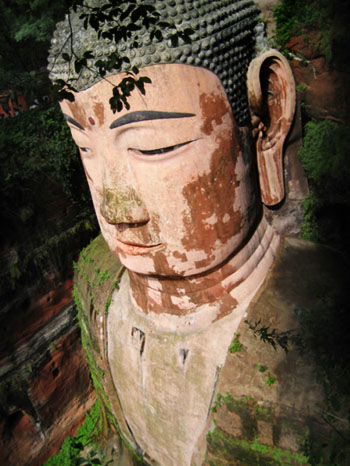 Chengdu Tour Guide
Chengdu Tour GuideLocal Chengdu Tours
Leshan Giant Buddha
Over the centuries, the cultural treasures springing from the fertile Sichuan Basin region have grown in number. Among them, the most remarkable is the Leshan Giant Buddha. As the largest Buddha statue in the world, the Leshan Giant Buddha draws millions of tourists and Buddhist pilgrims from all over the world.
The Giant Buddha lies to the east of the city of Leshan in Sichuan Province at the confluence of the Minjiang, Dadu and Qingyi rivers. The statue faces the sacred Mount Emei with the rivers flowing below its feet.
 |
 |
| The overview of the Leshan Giant Buddha. | The profile of the Leshan Giant Buddha. |
The Leshan Buddha statue is a stout, smiling monk, calmly sitting resting his hands upon his knees. He is believed to be Maitreya, a Buddha and disciple of Sakyamuni, who is said to have founded Buddhism. Worshiping Maitreya was especially popular between the 4th and 7th centuries. Today images of him can still be found in scores of Buddhist temples throughout China, conveying his characteristic air of expectancy and promise. The Leshan statue is the most spectacular of them all.
According to records, it took 90 years to carve the huge Buddha from the first year (713) of the reign of Emperor Xuanzong of the Tang Dynasty (618-907) to the 19th year (803) of Emperor Dezong's reign. The huge project is said to have been the brainchild of a Chinese monk named Hai Tong, who hoped the Buddha would calm the turbulent waters that plagued passing boats.
 |
 |
| What a great the Leshan Giant Buddha. | Many people stand on the foot of Leshan Giant Buddha. |
The size of the Giant Buddha is truly amazing. It stands 70 meters tall (230 feet). Its head is 15 meters (50 feet) high, while its nose is 6 meters (20 feet) long and its fingers are 3 meters (10 feet) long each. Even its smallest toenail can accommodate a seated person. The entire statue is made of stone, except for the ears which were crafted of wood, affixed, and then covered with clay.
Another architectural wonder is the drainage system. It is a complex system made of hidden gutters and channels, which carry away rainwater and keep the inner parts dry. This complex drainage system is a major reason why the statue has survived intact so long. The best views of the Buddha are onboard a boat on the river or from the hills that flank its head.
Select Other Favorite Attractions
|
||||||
|
|
|||||
|
||||||
Guide for China tour, offers most value & amazing experience. In China, you can rely on us
Copyright © 2001 - 2025. All Rights Reserved to ChinaTourGuide.Com
Hotel Guangzhou | Guizhou Tours | Hong Kong Hotels | 香港酒店 | 广州酒店 | 广州会议酒店 | Indochina Tour
Guide for China tours, offers most value & amazing experience. Chinatourguide.com. Your reliable China tour agency.






